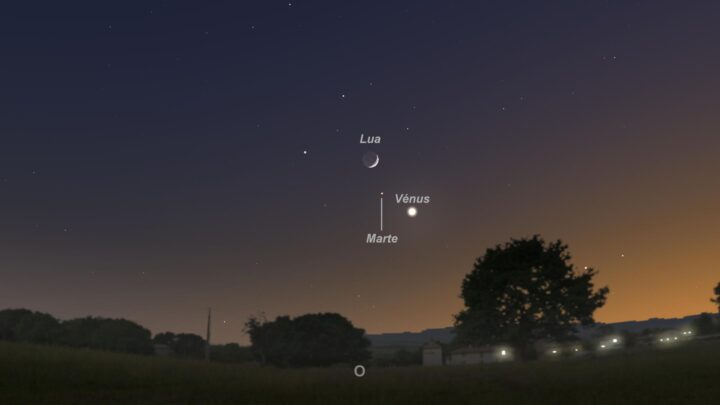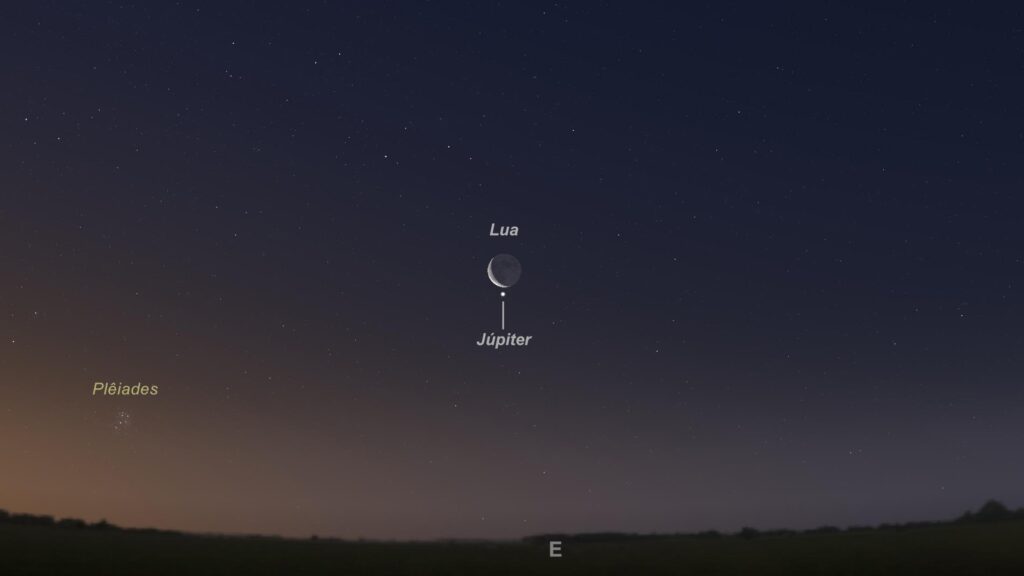For most of this month of June 2023, it is possible to observe all planets visible to the naked eye.
For early risers, Mercury appears a little to the right of sunrise and close to the horizon, just before dawn. The planet will not be very high in the sky, so to see it, you need a clear view of the horizon, facing east.
Jupiter and Saturn are also visible at dawn, but appear earlier and earlier, with Jupiter rising around 04:30 am at the beginning of the month and around 02:45 am at the end of the month. Saturn, on the other hand, rises around 02:15 am, at the beginning of the month, but starts to be seen around half past midnight, at the end of the month.
At dusk, we see the remaining planets, with Venus, in its afternoon “star” version, visible just before dusk, in the West. At the end of the month, this planet, which was moving away from the Sun, in the sky, reverses direction and begins the path of approaching our star.
As for the Moon, on the 4th it reaches the full moon phase and, three days later, it reaches its apogee, that is, the point of closest approach to Earth in its monthly orbit, around 364 thousand kilometers from our planet.

On the 10th of June, Portugal, Camões and the Portuguese Communities day, the Moon, which rises around 2 am, passes at about 5 degrees from the planet Saturn.
On the afternoon of that day, anyone passing by the Planetarium of Porto – Centro Ciência Viva, will be able to see the public premiere of “O Céu d'Os Lusíadas”, the new immersive session of its own production, about the most emblematic parts and the immense astronomical references in the epic work of Camões, in addition to the astronomical ephemeris that occurred during the poet's lifetime.
On the 14th, the waning Moon passes about 0,3 degrees from Jupiter, at dawn. A little to the left of these “glued” stars is the Pleiades star cluster, also known in Portugal as the “seven-star”, which this month begins to be visible again, at dawn.
Two days later, a thin waning of the Moon passes about 2 degrees below the Pleiades and 6 degrees above the planet Mercury. On the 17th, the Moon is about 6 degrees to the left of this planet, and the next day it reaches the new moon phase.
And on the 21st, at 15:57 pm, the solstice (summer in the northern hemisphere) occurs. This is the day when the Sun will be above the horizon for the longest time and, on its passage to the South, at midday, it will be the highest in the sky of the entire year.
This is the longest day of the year: in the city of Coimbra, for example, the sun rises at 06:04 and sets at 21:07, taking 15 hours and 03 minutes to travel across the sky.
But although this is the day when our hemisphere receives the most energy from the Sun, it is not the hottest day of the year, as temperatures continue to rise for a few weeks, due to the Earth's thermal inertia.
At dusk on the 22nd, Mars will be midway between the Moon and Venus. The three stars, visible at dusk, will be contained in an area smaller than a fist, observed at the distance of an outstretched arm.
And, almost closing the month, on the 26th, the Moon reaches the first quarter.
Good remarks!
Author Ricardo Cardoso Reis (Porto Planetarium and Institute of Astrophysics and Space Sciences)

















Comments